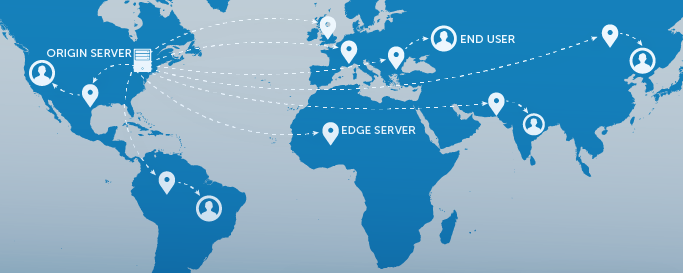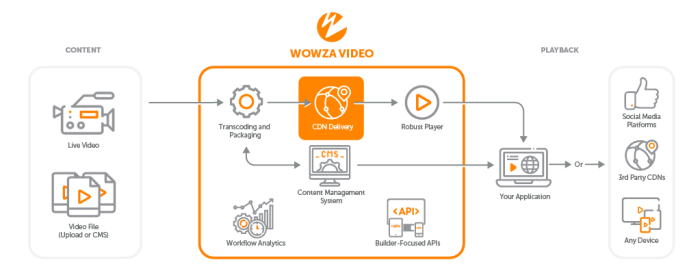How Do Content Delivery Networks (CDNs) Work?

Content Delivery Networks (CDNs) have become increasingly important in our digital world, ensuring the fast and efficient distribution of content across the internet. As the demand for streaming media, e-commerce, and cloud applications continues to rise, CDNs have stepped up to meet the growing need for high-performance delivery of both static and dynamic content. But how do CDNs work to deliver content as quickly, reliably, and securely as they do?
Let’s start with a metaphor and then work our way deeper. A CDN functions like a network of Amazon distribution centers spread across multiple locations. Just as Amazon stores and delivers products to customers from the nearest distribution center, a CDN caches and serves content from the closest edge server to the user. This way, both Amazon distribution centers and CDN edge servers optimize delivery efficiency, reduce latency, and improve overall user experience. Now we’ve just thrown a lot of jargon at you and will continue to do so as we dig into various video CDN workflows. Let’s pause a minute to unravel key CDN terminology.
Table of Contents
Key Terminology
- Content Delivery Network (CDN): A group of interconnected servers that serve and cache internet content from locations closest to users, aiming to improve web performance, enhance user experience, and reduce loading times. In the case of video content, the CDN will acquire and cache video content upon request from the end user or when frequently requested.
- Origin Server: The source server that collects and distributes content to edge servers for delivery to end users. This is the hub for the web of connections.
- Edge Servers: Servers located at the edge of a network, responsible for delivering fresh content faster and minimizing timeouts, latency, and jitter in a CDN.
- Point of Presence (PoP): Geographically strategic data centers from where CDN edge servers deliver content to end users.
- Content Caching: The process of storing copies of content on multiple servers so that it can be quickly and easily accessed by users, improving load times and reducing costs.
- Load Balancing: The process of distributing network traffic evenly across multiple servers to ensure optimal resource utilization, maximize throughput, and minimize response time.
Understanding the CDN Map
The process of accessing cached content from a CDN network edge server is nearly transparent to the user. CDN management software dynamically calculates which server is geographically closest to the user, and it delivers the requested content based on those calculations. Edge servers communicate with the content’s origin server to provide the user with both cached and uncached content.

CDN Workflow: Live Streaming
A CDN workflow for live streaming involves several steps to ensure efficient delivery of live video content to end-users. Here’s how it works:
- Ingest: The live video stream is captured using a camera and sent to an encoder. The encoder optimizes the video stream by compressing and converting it into a digital format.
- Encoding: The encoder processes the video stream into multiple resolutions and bitrates using adaptive streaming protocols like Apple HTTP Live Streaming (HLS) or Dynamic Adaptive Streaming over HTTP (MPEG-DASH).
- Origin server: The encoded video stream is sent to the origin server, which acts as the primary source of the content for the CDN.
- Distribution: The CDN takes the video content from the origin server and distributes it across its network of edge servers located around the world.
- Caching: The edge servers cache the video content in segments as it continues to be recorded and streamed live, so it’s readily available for viewers in different geographical locations.
- Playback: When a viewer requests the live stream, the CDN directs the request to the nearest edge server, which delivers the video stream with minimal latency and buffering.
- Load balancing and redundancy: A multi-CDN strategy can be employed to optimize performance by allowing each CDN to handle specific tasks, ensuring seamless playback and better service for both broadcasters and viewers.
A CDN workflow for live streaming involves ingesting, encoding, distributing, caching, and playback of live video content, with the primary goal of providing a seamless and high-quality streaming experience to end-users. This is distinct from a video-on-demand format in that the streamed video is sent and cached incrementally as it is being recorded.
CDN Workflow: Video on Demand
A CDN workflow for VOD functions through a series of steps that ensure efficient content delivery to viewers. Here’s an outline of the process:
- Content preparation: The video content is first encoded into various formats and bitrates to cater to different devices and connection speeds
- Content storage: The encoded video files are then stored on an origin server, which is responsible for providing the content to the CDN’s edge servers.
- Edge server replication: The CDN’s edge servers, located strategically across the globe, store copies of the video content to serve viewers based on their location.
- Request and delivery: When a viewer requests a video, the CDN identifies the closest edge server to the viewer’s location. This server then delivers the content to the viewer, ensuring reduced latency and faster streaming times.
- Adaptive streaming: Modern CDNs use adaptive streaming technologies like MPEG-DASH and Apple HLS to adjust video quality in real-time based on the viewer’s network conditions, providing a smooth playback experience.
By distributing content across multiple servers, a CDN workflow for VOD ensures efficient content delivery, reduced latency, and an improved viewer experience.
CDN Features: A Closer Look
As the demand for faster and more reliable access to online resources grows, CDNs have stepped up to the challenge, offering a suite of features designed to enhance user experience, improve website performance, and secure data transmission. In this section, we will delve into the various features that make CDNs indispensable for businesses and developers alike.
CDN Caching
Caching is a critical aspect of a CDN’s functionality. CDN edge servers cache and store data, enabling them to quickly deliver content to users. Here is an example of a typical CDN caching process:
- A user requests content from a website, which is hosted on a web server in a specific location.
- The website’s origin server receives the request and sends a response to the user. Simultaneously, it delivers a copy of the response to the CDN point-of-presence (PoP) closes to the user.
- The CDN PoP stores the copy as a cached file.
- When the same or another user in the same location requests the same content again, the caching server delivers the response instead of the origin server.
By distributing content across multiple servers, CDNs can reduce load times, optimize bandwidth, and ensure a more reliable user experience.
Load Balancing
Load balancing and CDNs complement each other to provide a seamless and efficient content delivery experience. A CDN reduces latency and speeds up content delivery by caching and distributing content across multiple servers in different geographic locations. When a user requests content, the CDN directs them to the nearest server to minimize data transfer delays.
On the other hand, load balancing distributes incoming network traffic across multiple servers to ensure efficient resource utilization and prevent overloading. It achieves this by continuously monitoring server health and availability. It also intelligently routes traffic to the most appropriate server based on various algorithms and factors.
In a combined setup, the load balancer works at the origin server level, distributing traffic between the origin servers where the actual content is stored. The CDN then takes care of content caching and distribution to edge servers closer to end-users. This joint approach optimizes network performance, reduces server load, and provides a better user experience by delivering content faster and more reliably.
Solid State Features
Solid-state features for a CDN refer to the use of solid-state drives (SSD) in the caching servers. SSDs are a type of data storage device that uses NAND-based flash memory to store data, offering faster access to stored content compared to traditional hard-disk drives (HDD). By using SSDs in a CDN, providers can improve the speed and performance of content delivery, as these drives enable faster retrieval and loading of cached files. This ultimately contributes to reduced latency, improved page load times, and a better user experience for visitors accessing a website served by a CDN.
TLS/SSL
Transport layer security (TLS) and secure socket layer (SSL) refer to the encryption and security measures applied to ensure the safe and secure transmission of data between a server and web browser when using a CDN. CDNs are networks of servers distributed across multiple locations to serve content faster and more efficiently to users. Implementing proper TLS/SSL encryption with CDNs helps protect sensitive data, mitigate vulnerabilities, and maintain trust between the website and its users. The CDN establishes the first leg of the connection using the provider’s own certificate, hosted on a CDN proxy.
Getting Started with a Video CDN
When evaluating and choosing a CDN partner, consider factors such as global coverage, performance, support, and pricing. Find a streaming partner that provides solutions to scale with your needs, values security, and makes it easy to get started.

Take our CDN for a test drive with a Wowza Video free trial and find out why nearly a third of global CDNs have Wowza built in.




